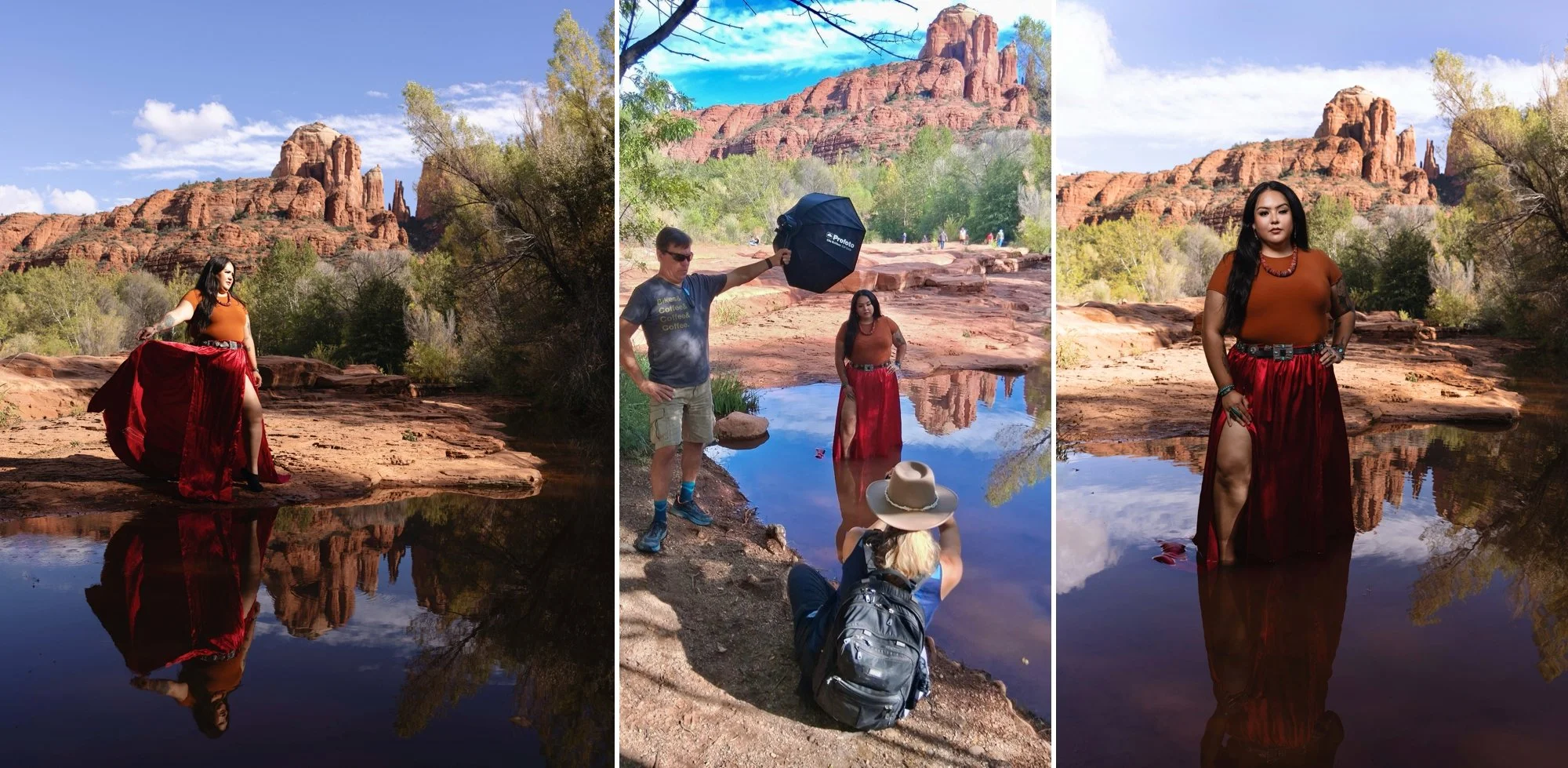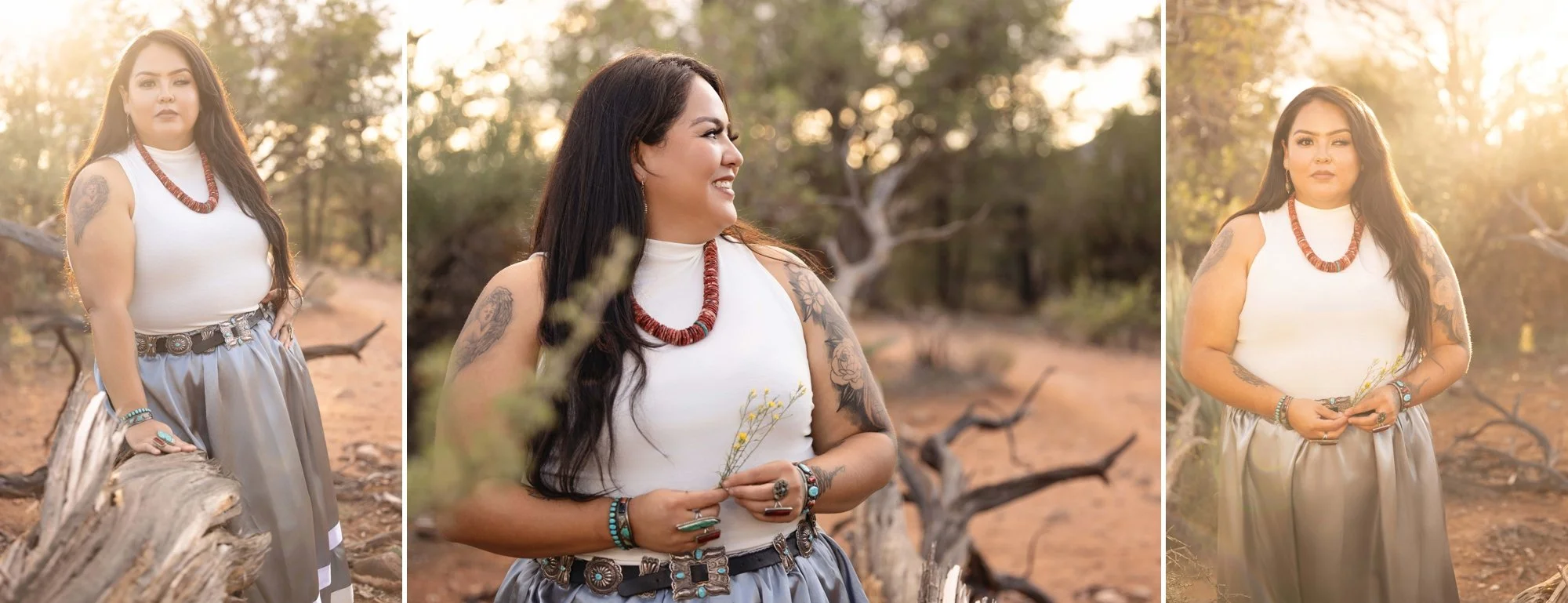Strength, Authenticity, and Rain — My 4th Diné Women Empowerment Session in Sedona, Arizona
The rain came — soft, cleansing, alive.
Chasity lifted her face to the sky and claimed her space.
This is strength: not in resistance, but in the quiet power of self-acceptance.
For the Diné, rain is a blessing — and on this day, it blessed her courage.
When I began the Diné (Navajo) Women Empowerment Series, I hoped to create a body of work that honors Indigenous women not as stereotypes or symbols, but as whole, powerful human beings — resilient, radiant, and deeply connected to their heritage and to the land.
For my fourth session, I had the privilege of photographing Chasity in Sedona, Arizona — a woman whose strength, openness, and beauty moved me deeply.
Chasity, Diné woman, holding a handmade basket among reeds in Sedona, AZ
Connection and Authenticity
Chasity came to me through Tiana, my first Diné portrait in this series. When we began planning her session, Chasity asked if her plus-size body would be a problem. My immediate response was, “Absolutely not. I want authenticity.”
She then mentioned that she has cataracts in one eye and wondered if that would be an issue.
I asked, “Does it bother you?”
She replied, “No — it’s part of who I am.”
Perfect. We moved forward.
Her enthusiasm was contagious — the kind of energy that makes an artist even more inspired. We set our shoot for a Saturday, but the desert had other plans. Heavy rain and flash flood warnings forced us to reschedule. Yet in true Chasity spirit, she texted me that in Diné tradition, rain is a cleansing blessing — and she was open to being photographed in it.
Chad and Chasity share a tender moment. Chasity made Chad his patterned vest.
The Portrait Journey
The next day, we began at Crescent Moon Ranch, where I envisioned Chasity framed against the majestic Cathedral Rocks with reflections in the Oak Creek River. She brought her handmade ribbon skirts, one featuring a confident front slit, and her husband Chad came to help and support her — just as my husband, Jeff, was there supporting me.
Our first portraits featured Chasity holding a Navajo Wedding Basket, symbolizing unity and continuity. As I looked around, I noticed tall green reeds — and knew instantly they would frame her beautifully in her burnt-orange top.
Later, she changed into a rich red ribbon skirt, and we ventured into the cool waters of Oak Creek. The clear reflection of Cathedral Rock behind her felt almost spiritual — as though the earth and sky were bearing witness to her power.
Chasity reflected beautifully in the Oak Creek River with Cathedral Rock looming in the background. Sedona, Arizona.
Sacred Light and Symbolism
Our second location was Secret Slickrock, offering another perspective of Cathedral Rock — a sacred formation to many. Despite crowds (and even a nearby wedding!), we found moments of stillness.
We played near a fallen juniper tree, symbolic to the Navajo for its use in building hogans — the traditional home that anchors family and culture. The wood, weathered but strong, mirrored the spirit of the women I’ve photographed in this series.
And then — as if on cue — the rain returned.
Golden light streamed through droplets as Chasity lifted her face to the sky, radiant and grounded. She told me she wanted “power poses,” and that’s exactly what we created — portraits of self-possession and grace.
In contrast to Edward S. Curtis’s late 1800s/early 1900s series The Vanishing Race, which often depicted Indigenous people as fading from existence, these portraits honor Navajo women as vibrant, resilient, and powerfully present.
Reflections on Representation
So much of history has shown Indigenous men in ceremonial regalia — rarely women, and seldom in the fullness of their modern power. I think of the late 1800s photographer, Edward S. Curtis, who labeled his series “The Vanishing Race.” The Indigenous people were stoic and stiff. I understand that this could be a reflection of the times.
But the Diné women I’ve had the honor to photograph — Tiana, Angell, Lorena, and now Chasity — are anything but vanishing.
They are rising.
In our interview, Chasity said something that still makes me smile:
“Employers like to hire Navajo women because we get sh*t done.”
She embodies that truth — strength wrapped in warmth, determination balanced with humility.
Chasity, wrapped in a traditional blanket at sunset, made by Pendleton.
Each woman in this series has expanded my understanding of resilience, beauty, and cultural pride. I hope to continue photographing more Diné women of diverse ages and stories (with grant support) — and one day, to exhibit this work so that their voices and images are seen and celebrated.
To Chasity — thank you for your courage, authenticity, and light.
And to the rain — thank you for your blessing.






